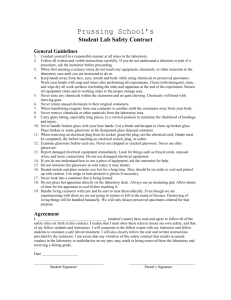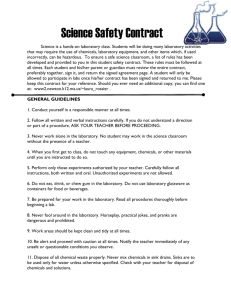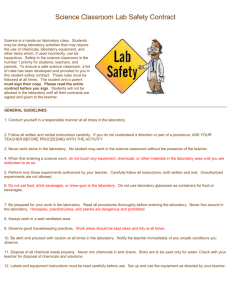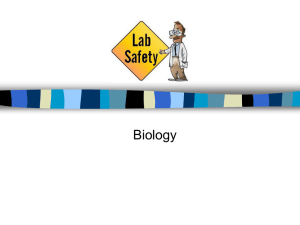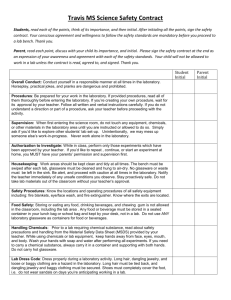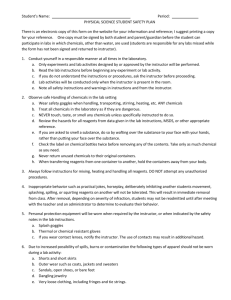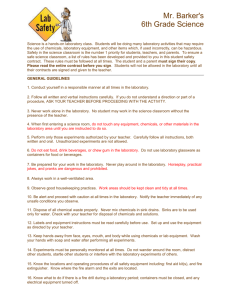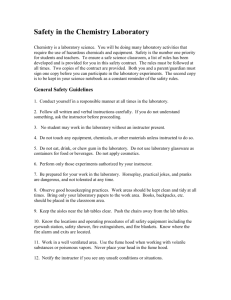Organic chemistry 1 PHS 142 #1 - phs243
advertisement
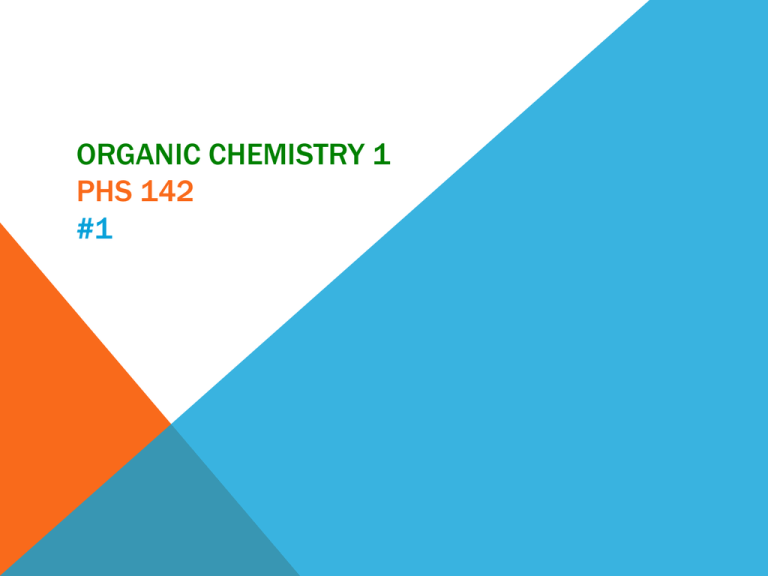
ORGANIC CHEMISTRY 1 PHS 142 #1 Phs243.wikispaces.com Lab # The topic 1 Lab safety 2 Distillation and recrystallization 3 TLC 4 Extraction of caffeine 5 Reduction of carbonyl group 6 NS 7 Alkene addition reaction 8 Alcohol properties 9 NMR 10 MS and IR LAB SAFETY GENERAL GUIDELINES • Conduct yourself in a responsible manner at all times in the laboratory. • Follow all written and verbal instructions carefully. If you do not understand a direction or part of a procedure, ASK YOUR TEACHER BEFORE PROCEEDING WITH THE ACTIVITY. • Never work alone in the laboratory. • When first entering a science room, do not touch any equipment, chemicals, or other materials in the laboratory area until you are instructed to do so. GENERAL GUIDELINES • • Do not eat food, drink beverages, or chew gum in the laboratory. Do not use laboratory glassware as containers for food or beverages. Work areas should be kept clean and tidy at all times. • Dispose of all chemical waste properly. Never mix chemicals in sink drains. Sinks are to be used only for water. Check with your teacher for disposal of chemicals and solutions. • Labels and equipment instructions must be read carefully before use. GENERAL GUIDELINES • Keep hands away from face, eyes, mouth, and body while using chemicals or lab equipment. Wash your hands with soap and water after performing all experiments. • Experiments must be personally monitored at all times. Do not wander around the room, distract other students, startle other students or interfere with the laboratory experiments of others. • Know the locations and operating procedures of all safety equipment including: first aid kit(s), and fire extinguisher. Know where the fire alarm and the exits are located. CLOTHING • • • • Any time chemicals, heat, or glassware are used, students will wear safety goggles. Contact lenses may be not be worn in the laboratory. Dress properly during a laboratory activity. Long hair, dangling jewelry, and loose or baggy clothing are a hazard in the laboratory. Long hair must be tied back, and dangling jewelry and baggy clothing must be secured. Shoes must completely cover the foot. No sandals allowed on lab days. A lab coat or smock should be worn during laboratory experiments. ACCIDENTS AND INJURIES • Report any accident (spill, breakage, etc.) or injury (cut, burn, etc.) to the teacher immediately, no matter how trivial it seems. Do not panic. • If you or your lab partner is hurt, immediately (and loudly) yell out the teacher's name to get the teacher's attention. Do not panic. • If a chemical should splash in your eye(s) or on your skin, immediately flush with running water for at least 20 minutes. Immediately (and loudly) yell out the teacher's name to get the teacher's attention. • • • • HANDLING CHEMICALS All chemicals in the laboratory are to be considered dangerous. Avoid handling chemicals with fingers. Always use a tweezer. When making an observation, keep at least 1 foot away from the specimen. Do not taste, or smell any chemicals. Check the label on all chemical bottles twice before removing any of the contents. Take only as much chemical as you need. Never return unused chemicals to their original container. Never remove chemicals or other materials from the laboratory area. • Never smell a material in a test tube or flask directly. Instead, with your hand, waft some of the fumes toward your nose carefully. ✖ ✔ HANDLING GLASSWARE AND EQUIPMENT • Never handle broken glass with your bare hands. Use a brush and dustpan to clean up broken glass. Place broken glass in the designated glass disposal container. • Examine glassware before each use. Never use chipped, cracked, or dirty glassware. • If you do not understand how to use a piece of equipment, ASK THE TEACHER FOR HELP! • Do not immerse hot glassware in cold water. The glassware may shatter. HEATING SUBSTANCES • Do not operate a hot plate by yourself. Take care that hair, clothing, and hands are a safe distance from the hot plate at all times. Use of hot plate is only allowed in the presence of the teacher. • Heated glassware remain very hot for a long time. They should be set aside in a designated place to cool, and picked up with caution. Use tongs or heat protective gloves if necessary. • Never look into a container LABORATORY GLASSWARE LABORATORY GLASSWARE • Glass Beaker • Glass media bottles LABORATORY GLASSWARE • Glass flasks • Glass graduated cylinder LABORATORY GLASSWARE • Glass funnels • Glass burets LABORATORY GLASSWARE • Glass test tubes • Glass pipettes LABORATORY GLASSWARE • Glass stirring rods • Glass spatula USING FILTER PAPER • Using filter paper is a procedure used to separate liquids from insoluble solids. LABORATORY SAFETY SYMBOLS Toxic/Poison – A substance that can lead to death if inhaled, ingested, or absorbed by the skin. Corrosive – A substance that can destroy or burn living tissue and can eat away at other materials. Irritant - A substance that causes inflammation upon contact with skin or mucous membranes. Environmental - Substances that are harmful to the environment. They must be disposed of properly, not washed down the drain. THANK YOU
